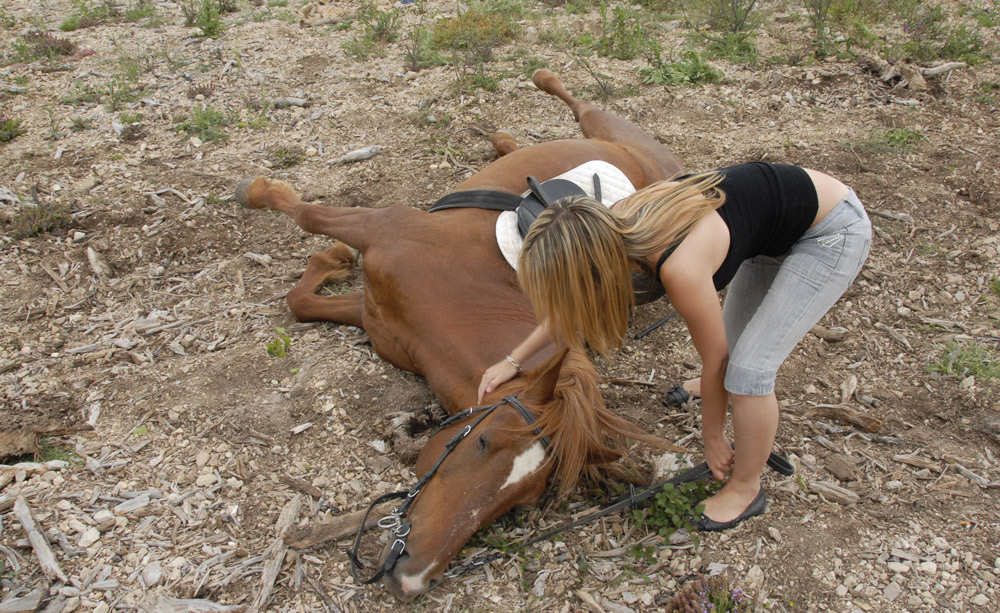Being able to evaluate your horse’s vital signs during a potential health crisis can mean the difference between getting him appropriate help in time, or waiting until it is too late.
Heaven forbid your horse should experience a health crisis, but if he does, are you prepared? Do you know how to take your horse’s basic vital signs, can you tell what those signs mean, and do you understand how to determine when he may be in trouble? Even if he has always been healthy, you just never know when he might develop a health crisis. Below are seven key assessments you should learn how to do.
Temperature
Have your horse tied, or have someone holding him. Lightly lubricate the end of your thermometer with K-Y jelly or a similar water-based, water soluable lubricant. Move your horse’s tail to the side by the dock, and carefully insert the thermometer into his anus. Be sure to stand in a safe area, in case he objects.
If you are using a digital thermometer, it will tell you when time is up. A mercury thermometer will take a few minutes to give you a reading. Your horse’s resting temperature will typically fall between 99.5ºF and 101ºF.
Clean the thermometer before storing it again. Note: It can be a good idea to tie a string to the end of your thermometer, so it doesn’t get “lost” while you are taking your horse’s temperature. That creates a fun adventure!
Pulse Pulse
rates vary depending on the horse’s age. Become familiar with your horse’s normal pulse. Typical pulse rates are:
Adults: 30-40 bpm (beats per minute)
Two year olds: 40-50 bpm Yearlings: 45-60 bpm
Foals: 70-120 bpm
Using two or three fingers, press upwards/inwards on the main artery that runs underneath your horse’s cheekbone. Once you locate a pulse, time the number of beats within a 15-second interval, and multiply this by four to get your horse’s bpm. Note: Do not use your thumb to take your horse’s pulse – you may end up feeling your own pulse!
Respiration
Your adult horse’s respiration will be around eight to 15 breaths per minute. You can measure this by feeling or watching your horse’s side/ribcage as he breathes, and counting the breaths for one minute. An exhale/inhale counts as one breath, and your horse should inhale/exhale at equal rates.
Dehydration
The easiest way to test for basic dehydration is the pinch test. Pinch a fold of skin on your horse’s neck. The skin should spring back and flatten quickly. If it stays tented, your horse is likely dehydrated.
Gut Sounds
Gut sounds should always be present in your horse. A lack of gut sounds is cause for alarm. You can listen for them by pressing your ear to your horse’s side, or by using a stethoscope. You will need to listen for sounds on both sides of your horse, and in the upper and lower quadrants.
Capillary Refill
Your horse’s capillary refill time (a measure of circulation) should be fairly quick, one to two seconds. To test this, lift your horse’s upper lip and press your thumb against his gums for two seconds, blanching the area. Remove your thumb, and judge the amount of time it takes for the normal color to return to the area.
Mucous Membranes
The color of your horse’s mucous membranes (gums, nostrils and lining of eyelids) can be a good indicator of his overall health. If he is healthy, his gums should only be slightly paler than your own.
If the membranes are very pale, the capillaries have contracted. Your horse may have a fever, blood loss or anemia. Membranes that are bright red indicate the capillaries have enlarged, as seen in horses with shock or toxicity. Gray or blue membranes can indicate more severe shock, or illness, while yellow membranes are seen with jaundice and liver issues.
Make sure you understand how to take your horse’s vital signs, what they mean, and when the signs point to a potential health issue. When in doubt, ask your veterinarian to show you how to take your horse’s vitals – it will help everyone in the long run, since in an emergency, any extra information you can give your veterinarian ahead of time can speed up the diagnosis process. Don’t wait until you need to know these assessments to learn them – becoming well versed in them in advance can be a lifesaver








